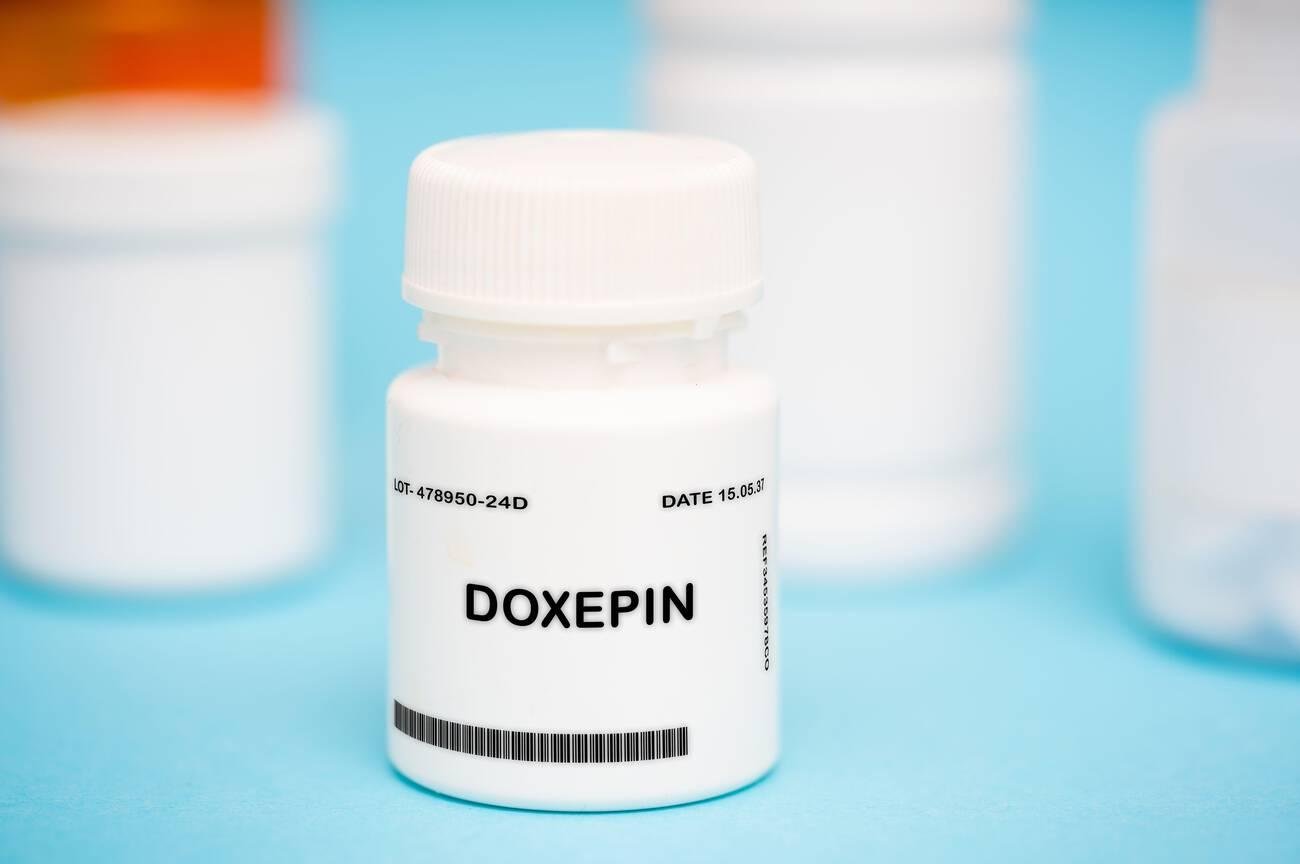Image Credit: Alamy
The question of “Why is doxepin discontinued?” has piqued the curiosity of many, especially those who have relied on this medication for managing conditions such as insomnia, anxiety, and depression. Doxepin, a medication with a multifaceted application in treating mental health disorders, has been a staple in the pharmaceutical arena for years, revered for its efficacy in addressing complex symptoms. Its discontinuation has raised numerous questions, not just about its immediate impact on patients but also concerning the broader implications for treatment strategies in mental health care. The reasons behind its phase-out involve a complex interplay of clinical, regulatory, and market dynamics, underscoring the need for a deep dive into the nuances of pharmaceutical lifecycles.
This article seeks to unravel the narrative behind why doxepin was discontinued, examining the multifactorial reasons that led to this decision, from concerns over side effects like weight gain and blurred vision to shifts in medical guidelines and the advent of alternative medications such as amitriptyline. Additionally, it will explore the current availability of doxepin, including generic versions and dosages such as doxepin 10 mg and doxepin 50 mg for sleep, and the impact of its discontinuation on those who were prescribed it for insomnia, depression, and anxiety. Insights from patient experiences and expert opinions will be highlighted to shed light on the real-world consequences of discontinuing medication, offering a comprehensive look at not only the ‘why’ behind the discontinuation but also the path forward for affected individuals.
Overview of Doxepin
What is Doxepin?
Doxepin is a medication classified under tricyclic antidepressants (TCAs), a group of drugs that are primarily used to treat mental and mood disorders such as depression and anxiety. Approved by the US Food and Drug Administration (FDA) in 1969, doxepin helps to restore the balance of certain natural neurotransmitters in the brain, enhancing mental balance and emotional stability. It functions by increasing the levels of neurotransmitters like serotonin and norepinephrine in the brain, which are crucial for regulating mood and behavior.

Common Uses of Doxepin
Doxepin’s applications extend beyond depression and anxiety. It is effectively used in the treatment of insomnia, where it helps to prolong sleep duration and reduce the frequency of awakenings during the night. This is believed to be due to its ability to block histamine receptors. Furthermore, doxepin is used in managing symptoms of chronic hives without a known cause, providing relief from severe itching and discomfort associated with allergic reactions.
In addition to its primary uses, doxepin is beneficial in treating a variety of other conditions. It is prescribed for the management of neuropathic pain and is used as a prophylactic agent against migraines. Its efficacy extends to the treatment of pruritus due to atopic dermatitis or lichen simplex chronicus, for which topical formulations are available. Moreover, doxepin has been utilized in pain management for conditions like urethral irritation and dysuria, showcasing its versatility as a tricyclic antidepressant.
Reasons for Discontinuation
The discontinuation of Doxepin, specifically the Sinequan® capsules, can be attributed to a variety of factors that influenced its presence in the pharmaceutical market. These factors include market trends, safety concerns, and manufacturing issues, each playing a pivotal role in the decision to cease production.
Market Trends
Doxepin saw a decrease in demand over the years, primarily due to the availability of newer and more effective medications. The National Electronic Library for Medicines reported the discontinuation of Doxepin in all strengths, highlighting a shift in preference towards alternative products. This shift was further evidenced in 2006 when there was no generic version available, leading to a seamless transition to generic alternatives as they entered the market.
Safety Concerns
Safety issues also contributed significantly to the discontinuation of Doxepin. Patients faced challenges such as hypersensitivity to the drug or its excipients, and there was a notable risk of overdose, which could be fatal. These concerns were compounded by the potential for severe withdrawal symptoms if the medication was abruptly discontinued, including nausea, headache, sleep disturbances, and generalized tiredness. Such risks necessitated a gradual tapering off under medical supervision to mitigate adverse effects.
Manufacturing Issues
Manufacturing complications further complicated the availability of Doxepin. In specific instances, like in New Zealand, the discontinuation was directly linked to the cessation of manufacturing by Mylan, the company producing Doxepin under the brand name Anten. This led to the drug not being available in the country, reflecting broader issues related to the global supply chain and production strategies.
These multifactorial reasons underscore the complex dynamics that influence the lifecycle of pharmaceutical products. The discontinuation of Doxepin highlights the need for continuous evaluation of medication efficacy, safety, and market demand to ensure optimal treatment options are available to patients.
Also Read: En Caul Birth: Why It Happens and What It Means for Your Baby
Current Availability and Alternative Medications

Generic versions
Doxepin remains available in generic forms, ensuring continued access despite the discontinuation of the brand name versions. The FDA has approved generic versions of doxepin, including doxepin hydrochloride tablets from manufacturers such as ACTAVIS ELIZABETH, MSN, RK PHARMA, and STRIDES PHARMA, with strengths ranging from 3mg to 6mg. These approvals, dating from as early as July 26, 2013, to as recent as April 3, 2023, illustrate the ongoing availability and regulatory confidence in these alternatives.
Alternative antidepressants
Patients seeking alternatives to doxepin for conditions like insomnia, anxiety, and depression have various options. Trazodone, known for its sleep-inducing effects, serves as a cost-effective alternative, particularly in its generic form. It is also used for managing conditions such as fibromyalgia and major depressive disorder. For those requiring a change from their initial antidepressant therapy, switching guidelines recommend careful consideration of drug interactions and patient-specific factors. The switch may involve a tapering strategy or a washout period to minimize risk, depending on the clinical scenario and the antidepressants involved. Other tricyclic antidepressants like amitriptyline and nortriptyline, along with newer classes such as SNRIs and SSRIs, provide additional therapeutic options, each with distinct profiles suited to individual patient needs and conditions.
Patient Experiences and Expert Opinions
User Testimonials
Patients have shared varied experiences with doxepin, highlighting its impact on conditions like insomnia, anxiety, and depression. Many users have reported significant improvements in sleep quality and duration, citing doxepin’s effectiveness where other medications failed. For instance, one user mentioned that doxepin was the only medication that helped them sleep after trying numerous others, which often resulted in grogginess the next day. Others expressed relief in symptoms of anxiety and depression, noting that doxepin helped them regain a sense of normalcy and improved their overall quality of life.
However, some experiences have been less favorable, with individuals reporting severe side effects such as dry mouth, weight gain, and withdrawal-like symptoms when discontinuing the medication. These accounts underscore the variability in individual responses to doxepin, emphasizing the need for personalized medical guidance.
Expert Recommendations
Experts in the field of psychiatry and pharmacology stress the importance of careful monitoring when prescribing doxepin, especially due to its potent effects and the potential for side effects. They recommend a gradual tapering off the medication to avoid withdrawal symptoms and advise on the necessity of patient education about the drug’s effects and potential side effects.
Medical professionals also suggest considering alternative medications if doxepin’s side effects become unmanageable. They highlight the availability of newer antidepressants with fewer adverse effects, which could be more suitable for some patients. In cases where doxepin is deemed the best option, experts advocate for regular follow-ups to closely monitor the patient’s response to the medication and adjust the treatment plan as needed.
Overall, the combination of patient testimonials and expert opinions provides a comprehensive view of the effectiveness and challenges associated with doxepin, guiding future treatment decisions for similar cases.
Also Read: Croup in Adults: Identifying Symptoms and Seeking Treatment
Conclusion
Throughout the exploration of doxepin’s discontinuation, we’ve gleaned insight into the multifaceted reasons that led to its withdrawal from the market, ranging from safety concerns and market trends to the emergence of alternative therapies. This investigation not only highlighted the immediate implications for patients and healthcare providers but also emphasized the dynamic nature of the pharmaceutical industry and its impact on treatment landscapes. The transition towards generic versions and alternative medications underscores a critical facet of pharmaceutical care: adaptability and responsiveness to evolving medical needs and safety standards.
As we reflect on the journey of doxepin, from its widespread use in treating conditions like insomnia, anxiety, and depression to its gradual phase-out, it becomes evident that the evolution of medical treatments is an ongoing process. The insights gathered from patient experiences and expert opinions further enrich our understanding, guiding us toward more refined and patient-centered healthcare solutions. In moving forward, the doxepin narrative encourages continued research and dialogue within the medical community, ensuring that future transitions in medication availability prioritize patient safety, efficacy, and well-being above all.
FAQs
1. Has doxepin been discontinued?
Yes, doxepin hydrochloride has been restricted from being prescribed to new patients starting from March 1, 2019.
2. What makes doxepin a high-risk medication?
Doxepin is considered high-risk because it can cause QT prolongation, a condition that affects the heart’s rhythm. This can lead to severe, potentially fatal irregular heartbeats, along with other serious symptoms like severe dizziness and fainting, which require immediate medical intervention.
3. Was there a recall issued for doxepin?
Yes, there was a Class II recall initiated for doxepin on October 17, as part of a broader recall that included several other medications such as minoxidil, trazodone, clorazepate dipotassium, meclofenamate, diazepam, and lorazepam.
4. What is the black box warning associated with doxepin?
Doxepin carries a black box warning, the most stringent warning issued by the Food and Drug Administration (FDA). This warning highlights the risk of increased suicidal thoughts or actions in children, teenagers, and young adults who use the medication.



Leave a Reply